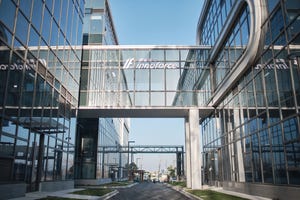
Catalent lays out plan to bring biologics biz back to brillianceCatalent lays out plan to bring biologics biz back to brilliance
Catalent attributed a 32% year-on-year drop in biologics sales in its postponed third quarter to the COVID-cliff and productivity issues but remains confident it can bring the division “back where it needs to be.”

Catalent attributed a 32% year-on-year drop in biologics sales in its postponed third quarter to the COVID-cliff and productivity issues but remains confident it can bring the division “back where it needs to be.”
Catalent had twice postponed its fiscal year third quarter results before this week’s financials were finally published, with the contract development and manufacturing organization (CDMO) citing forecasting issues and “productivity issues and higher-than-expected costs.”
But despite the company’s woes, the financials were better than expected, causing the share price to jump 11% Tuesday. Net revenue for the quarter dropped 19% year-on-year to $1.04 billion, with the firm’s Pharma and Consumer Health division remaining constant.

Image: DepositPhotos/
herminutomo
However, it was the Biologics division, which includes cell and gene therapy services, that felt the full weight of the COVID cliff – the diminishing contracts and revenues from the overly-robust demand that came with the pandemic – coupled with operational issues across the network. Net revenues stood at $475 million, a 32% decline year-on-year, while the EBITDA margin (operating profit as a percentage of revenue) was only 1.1% compared with last year’s healthy 31.1%.
While certain cost reduction actions were highlighted by the CDMO in a financial statement last month, CEO Alessandro Maselli spoke in depth and with much positivity about three areas of interventions that Catalent intends to implement to turn the ship around.
“The first one is regaining productivity at a couple of locations which have been significantly disrupted by a couple of events; one, remediation and two, correcting the course after a significant shift of the portfolio following the COVID-cliff,” he told stakeholders. “We started to see some first progresses in this quarter from an operational standpoint. And again, we will continue to work over the next period to address those productivity issues.”
The three sites affected by these issues are Catalent’s Harmans, Maryland gene therapy facility, the flagship Bloomington, Indiana biologics plant, and a cell therapy facility in Brussels, Belgium. Both the Bloomington and the Brussels plants received FDA 483s last year, highlighting manufacturing deficiencies.
“The second one is really aligning the headcount to the new mix,” Maselli said. While he admitted Catalent knows what the end point needs to be in terms of redundancies, he did not elaborate on potential numbers. Instead, he noted the need to do this “responsibly, respectfully, and take into consideration always the potential turmoil that these activities can generate.” According to local press, 400 jobs were axed at Bloomington in December last year, and a further 150 staff were laid off earlier this month.
The final element Maselli spoke about is the addressing of additional sites and assets, which Catalent has added to pursue new modalities, specifically cell therapies and plasmid.
“Look, the reality is that in a different world or with the different expectations, these sites would have registered revenues faster than what we are seeing. The reality is now clear to us, in terms of what could be an achievable revenue ramp there and now we are aligning our cost structure and cost investment to those new outlooks of revenues.” He added the firm will carefully bring these dilutive assets in to the mix in the short-term without affecting the margin of the segment.
“The timeline of the three items is different. So, that’s why it’s not very easy to point you to a specific date, but hopefully our understanding and plan gives you the confidence that over time we’re going to get back there.
He finished by saying “the pricing and the margin of the business, it’s the same that we experienced even before the pandemic. So, there is no reason that we cannot bring this segment back where it needs to be.”
About the Author
You May Also Like
schedl_b_and_w.jpg?width=100&auto=webp&quality=80&disable=upscale)
schedl_b_and_w.jpg?width=400&auto=webp&quality=80&disable=upscale)






